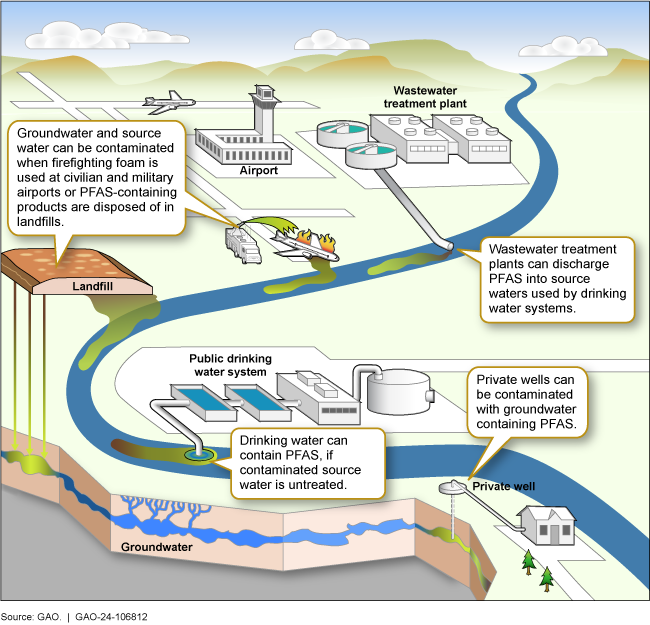Persistent Chemicals: Navy Efforts to Address PFAS at Joint Base Pearl Harbor-Hickam
Fast Facts
PFAS—a group of synthetic chemicals called per- and polyfluoroalkyl substances—are used in firefighting foams and other products. Some PFAS are linked to environmental contamination and human health problems.
This Q&A covers our work on the Department of Defense's detection and treatment of PFAS contamination at Joint Base Pearl Harbor-Hickam in Hawaii. In 2022, 1,300 gallons of firefighting foam was accidentally released there.
As of February 2024, DOD testing hadn't detected PFAS in the base's active drinking water supply. DOD is also assessing other known or potential PFAS contamination on base, developing long-term cleanup plans as needed.
Examples of How Per- and Polyfluoroalkyl Substances (PFAS) Enter Water Sources

Highlights
What GAO Found
As of February 2024, DOD testing had not detected any per-and polyfluoroalkyl substances (PFAS) in the active drinking water shaft at Joint Base Pearl Harbor-Hickam. PFAS are a large group of heat and stain resistant chemicals that can persist in the environment—including in water, soil, and air—for decades or longer. In November 2022, during maintenance activities 1,300 gallons of aqueous film-forming foam (AFFF) concentrate was released from a pipe in a tunnel at the Red Hill Bulk Fuel Storage Facility at Joint Base Pearl Harbor-Hickam in Hawaii. Because AFFF—a product used to fight flammable liquid fires—contains PFAS, this incident raised concerns about PFAS in the installation's drinking water and how the Department of Defense (DOD) remediates PFAS contamination at the installation.
Following the AFFF release, DOD took immediate action to ensure the AFFF was contained and removed from the affected area. Both DOD and the Environmental Protection Agency (EPA) have since completed investigations of the November 2022 AFFF release and issued final reports. Both investigations recommended that (1) increased government oversight of AFFF-related activities at the Red Hill facility was necessary, (2) all AFFF concentrate should be removed from the Red Hill facility, and (3) the AFFF system at Red Hill should be decommissioned.
On April 10, 2024, EPA announced a National Primary Drinking Water Regulation establishing allowable levels of 4 parts per trillion for certain PFAS in drinking water (one part per trillion is equivalent to a single drop of water in 20 Olympic-sized swimming pools). Prior to this, PFAS in drinking water were not regulated at the federal level. However, in 2016, under the authority of the Safe Drinking Water Act, EPA published health advisory levels of 70 parts per trillion for certain PFAS in drinking water. Since 2016, DOD has had policies in place for monitoring PFAS levels in drinking water at its installations at 70 parts per trillion. Joint Base Pearl Harbor-Hickam regularly monitors for PFAS in its active drinking water shaft at frequencies required by DOD policy and requests by EPA and the state of Hawaii. While PFAS have not been detected in the active drinking water shaft at the installation, low amounts of PFAS falling below 70 parts per trillion have been detected in the installation's two inactive drinking water shafts. These two shafts are currently not in use and according to DOD officials, the PFAS detected are not due to the November 2022 AFFF release. According to DOD policy and officials we met with, DOD will implement and comply with the April 2024 EPA regulation.
PFAS contamination at Joint Base Pearl Harbor-Hickam is being addressed by DOD's environmental restoration program. Through this program the Navy has identified 32 sites of known or potential PFAS contamination (e.g., soil or groundwater) at Joint Base Pearl Harbor-Hickam and is taking steps to assess these sites and, where appropriate, develop plans for their long-term cleanup. The Navy has finalized its preliminary assessment and site inspection reports for these 32 sites, with recommendations for the areas in 20 of these sites to advance to the in-depth remedial investigation phase of the environmental cleanup program. The remaining 12 sites were found to have no documentation of past use of AFFF or other potentially PFAS-containing products or materials.
Why GAO Did This Study
DOD has policies related to monitoring PFAS levels in drinking water at its installations, long term cleanup of PFAS contamination, and use and disposal of products containing PFAS. According to EPA, exposure to certain PFAS may have adverse effects on human health, including effects on fetal development, the immune system, and the thyroid, and may cause liver damage and cancer.
GAO was asked to examine DOD efforts to address PFAS contamination at Joint Base Pearl Harbor-Hickam. This report describes DOD's response to the November 2022 AFFF release at the installation; DOD processes for ongoing monitoring and long-term cleanup of PFAS at Joint Base Pearl Harbor-Hickam; and DOD's and EPA's policies addressing PFAS in the environment.
To conduct this work, GAO reviewed and summarized information from previous GAO reports and relevant DOD, EPA, and state of Hawaii guidance, policies, and other documentation on regulating release, response, use, and disposal of PFAS-containing substances. GAO interviewed DOD, EPA, and state of Hawaii officials and conducted a site visit to Joint Base Pearl Harbor-Hickam to observe the site of the November 2022 AFFF release. GAO met with Navy and state of Hawaii officials to understand the Navy's response to and cleanup of the release, as well as ongoing efforts to monitor and cleanup PFAS at Joint Base Pearl Harbor-Hickam.
For more information, contact Alissa Czyz at (202) 512-3058 or CzyzA@gao.gov.
